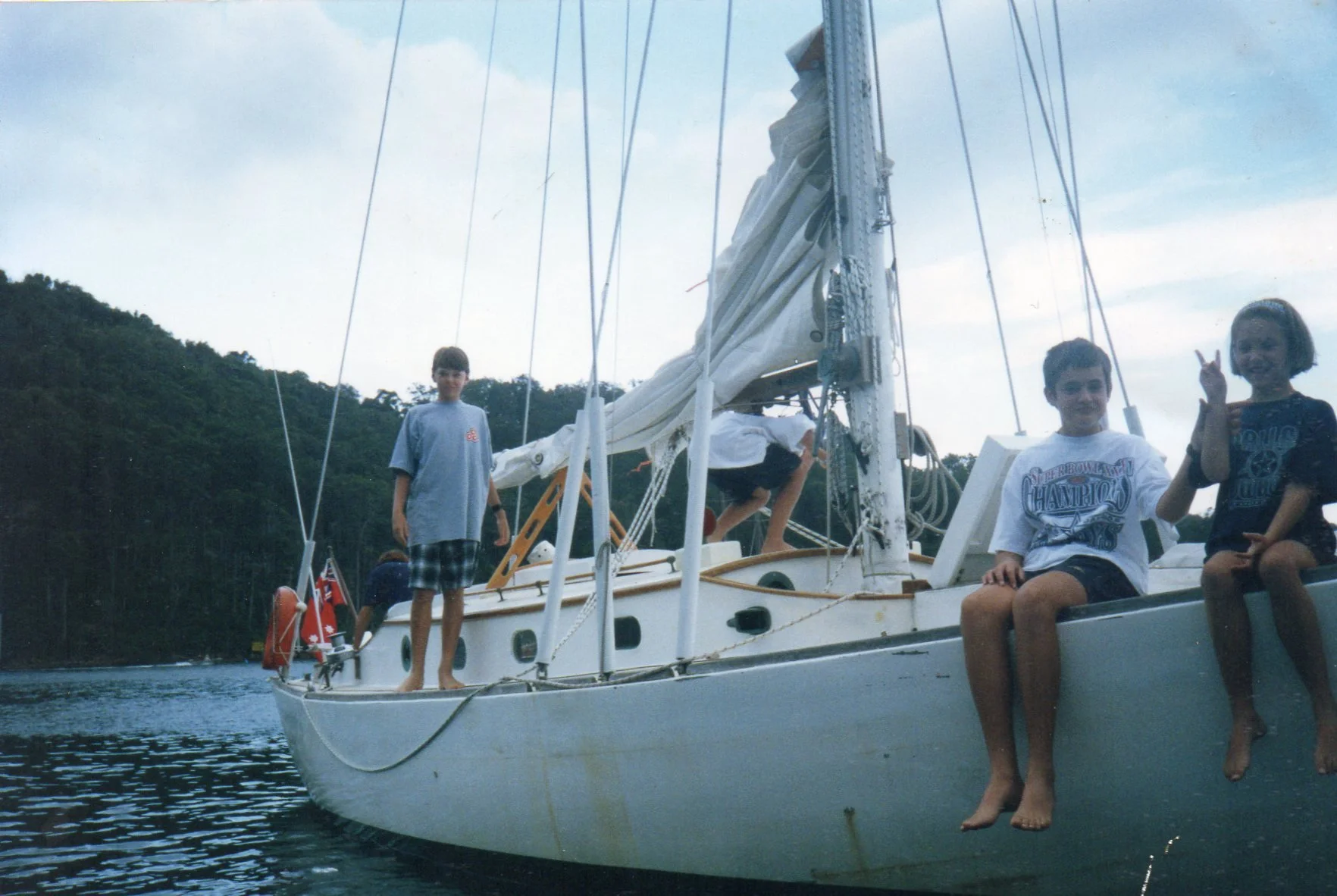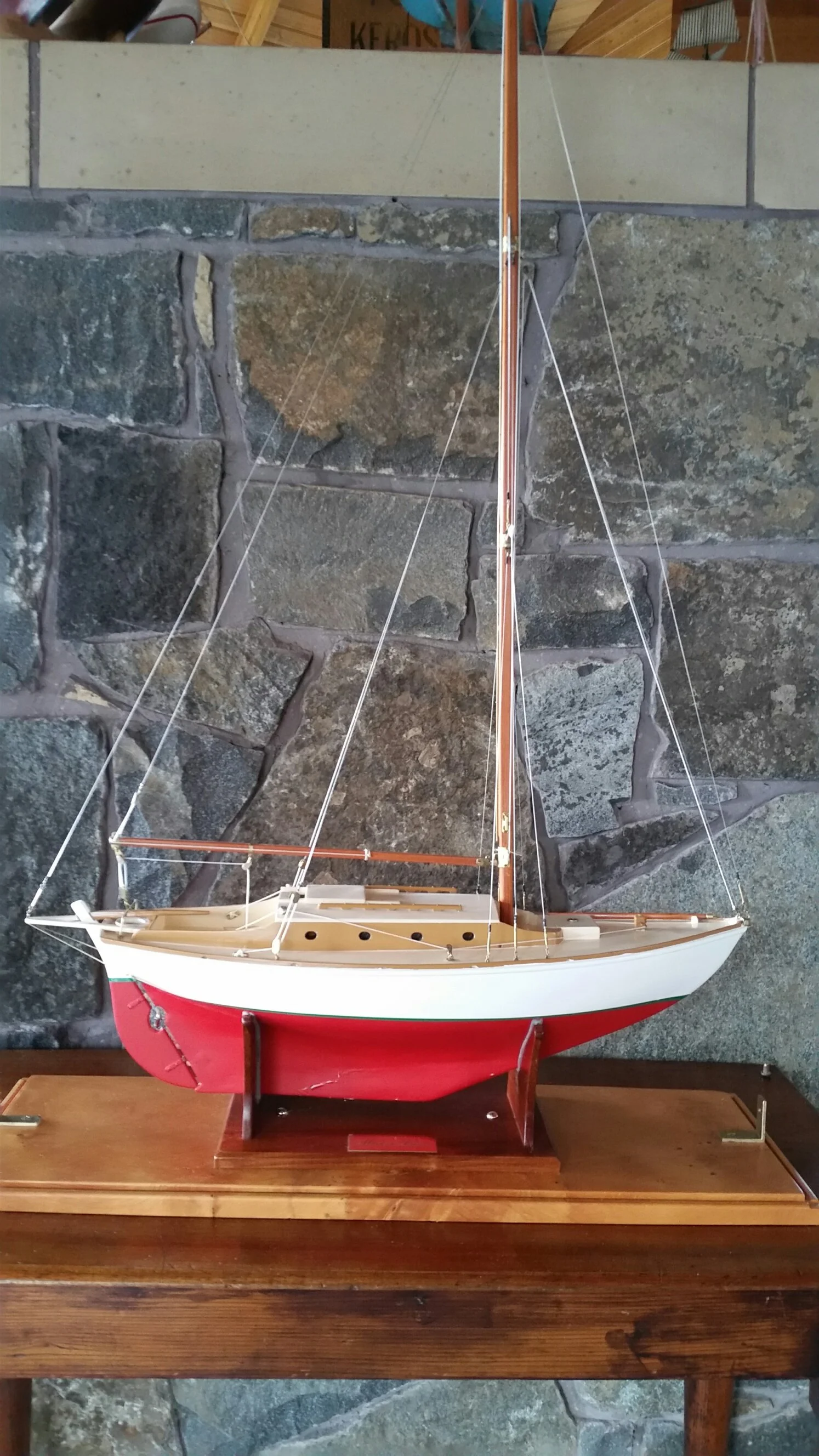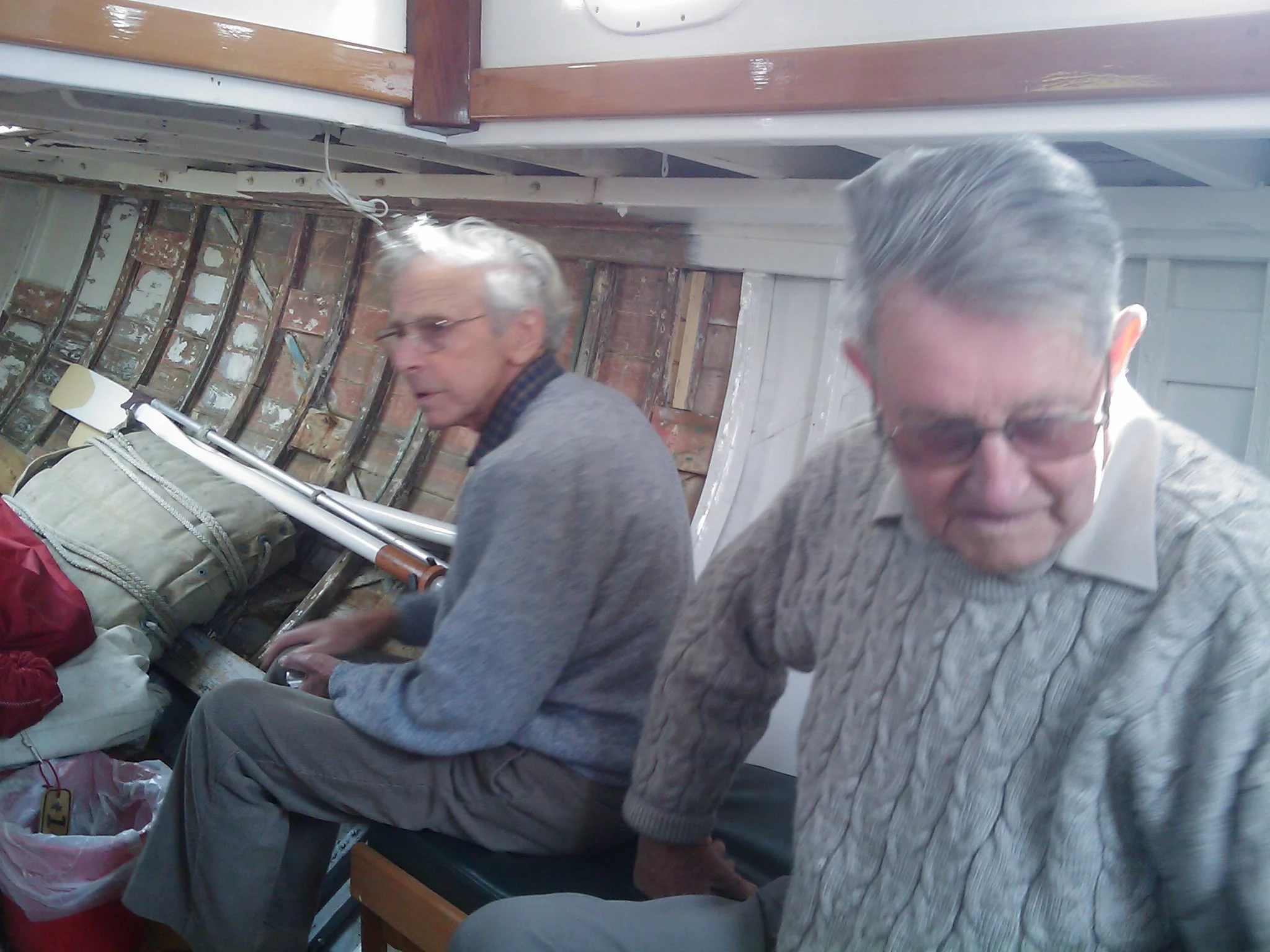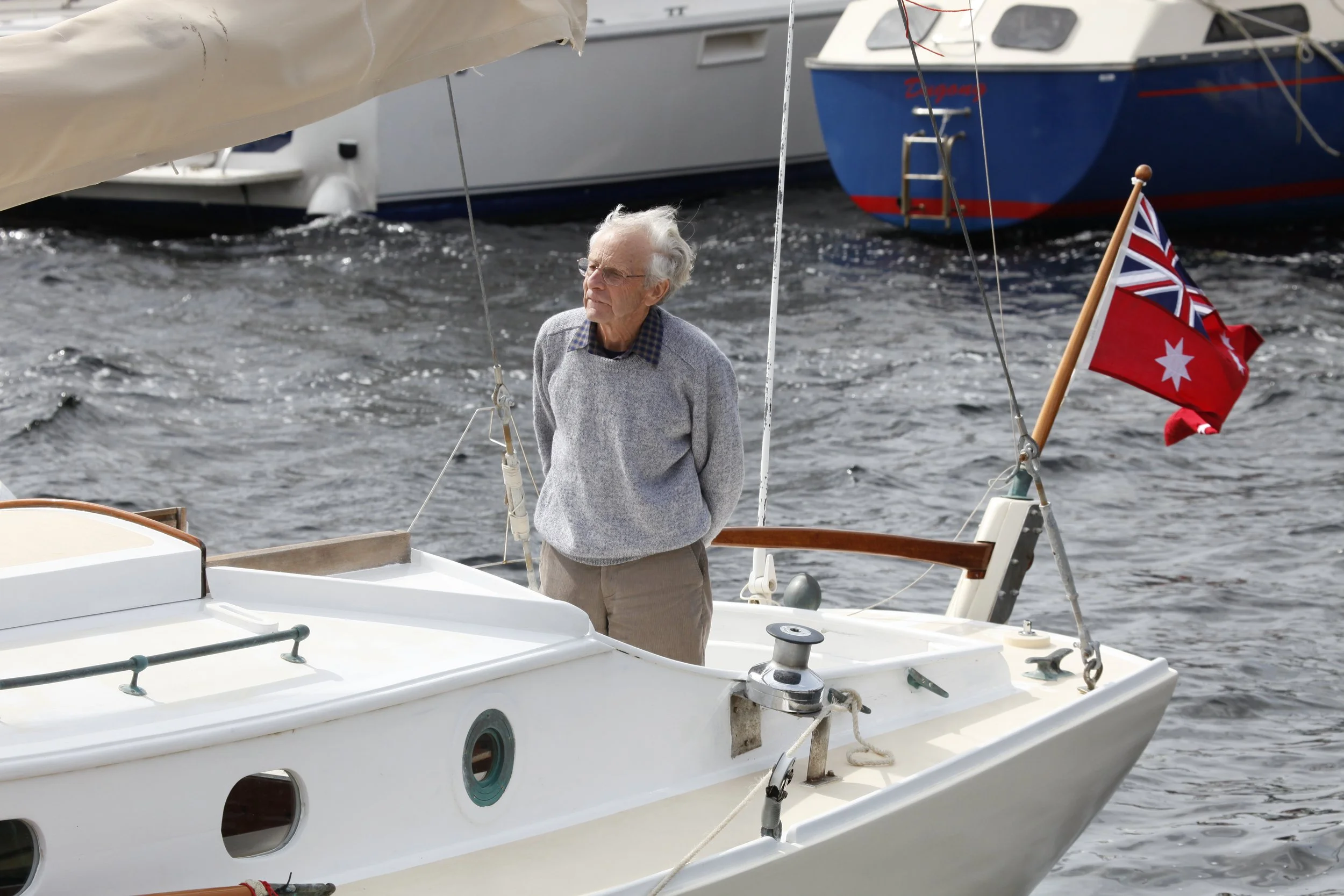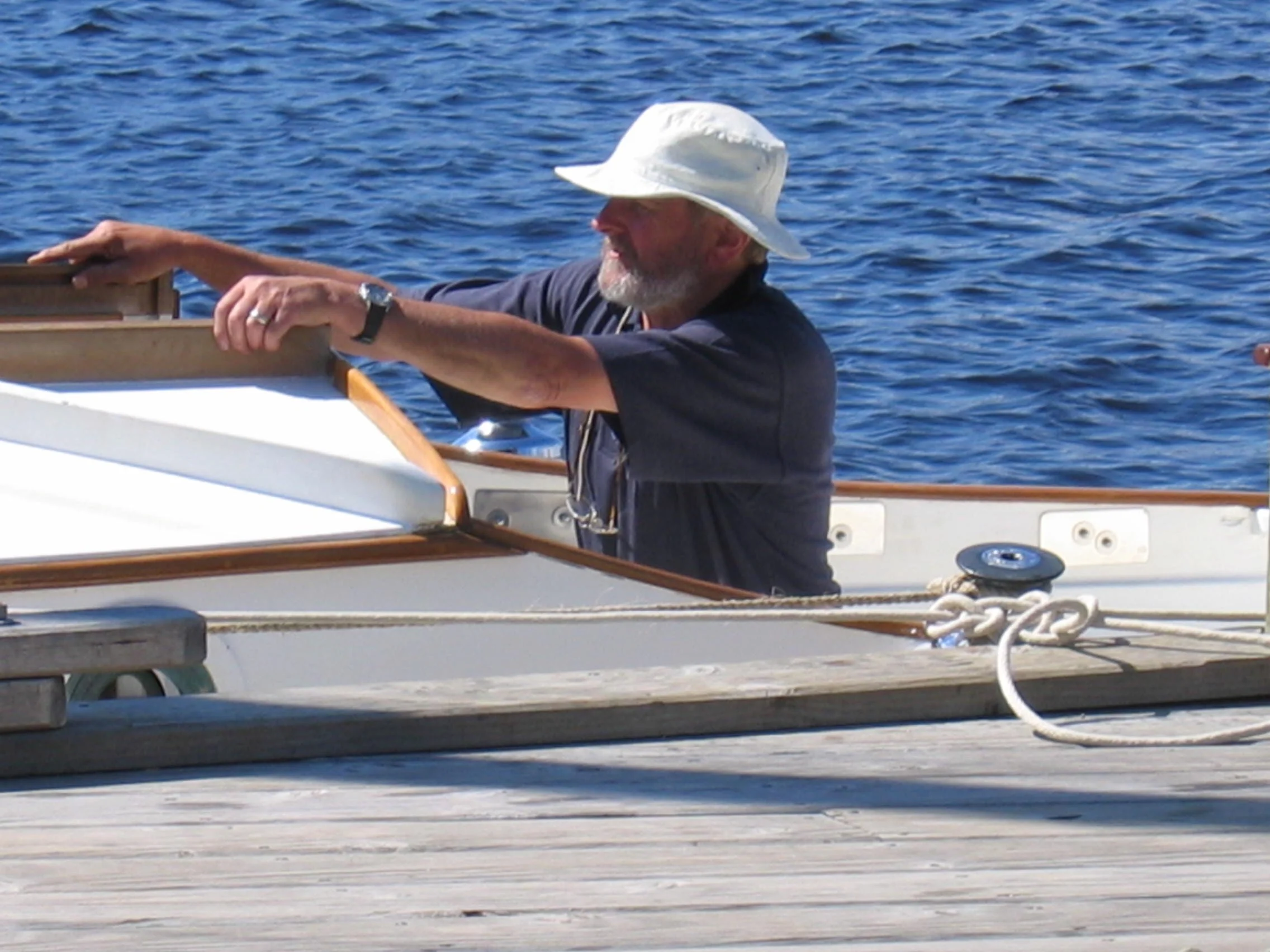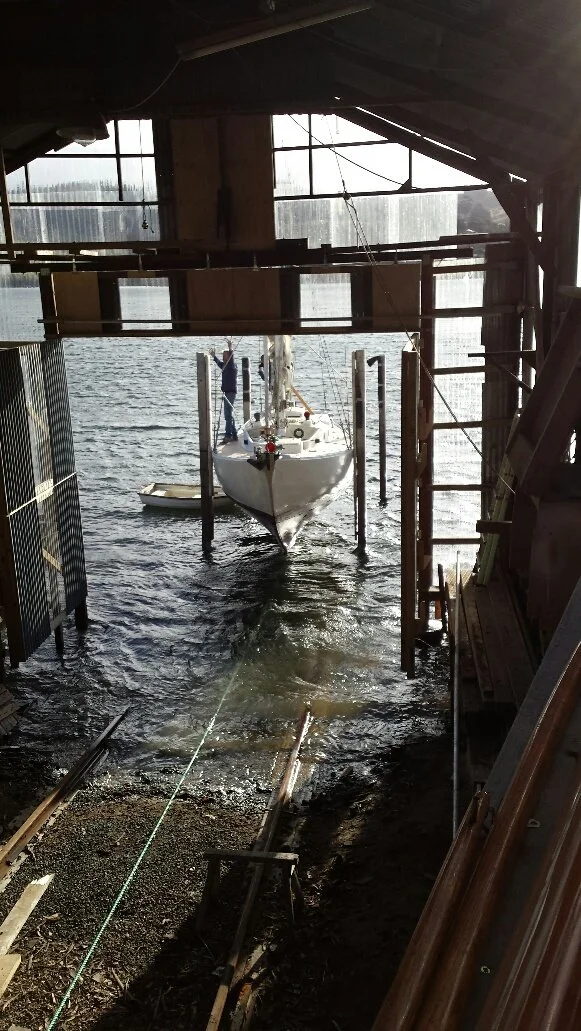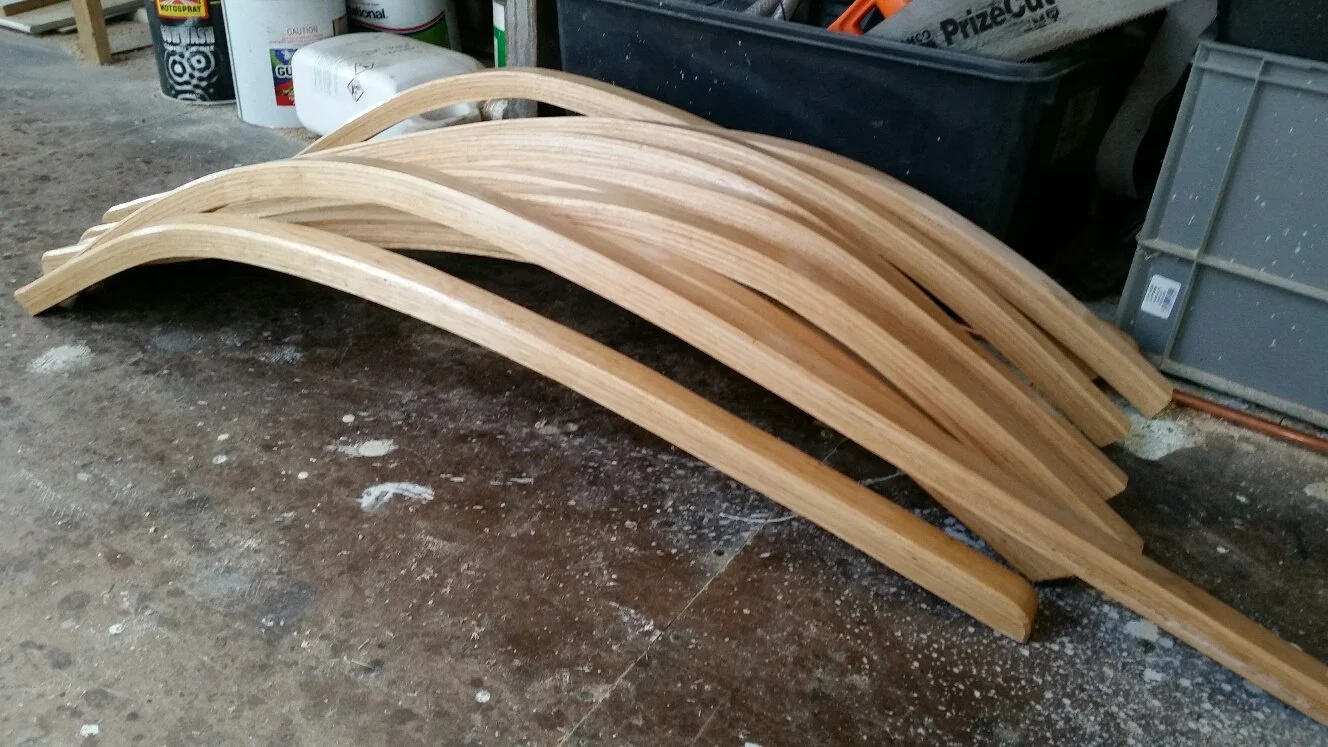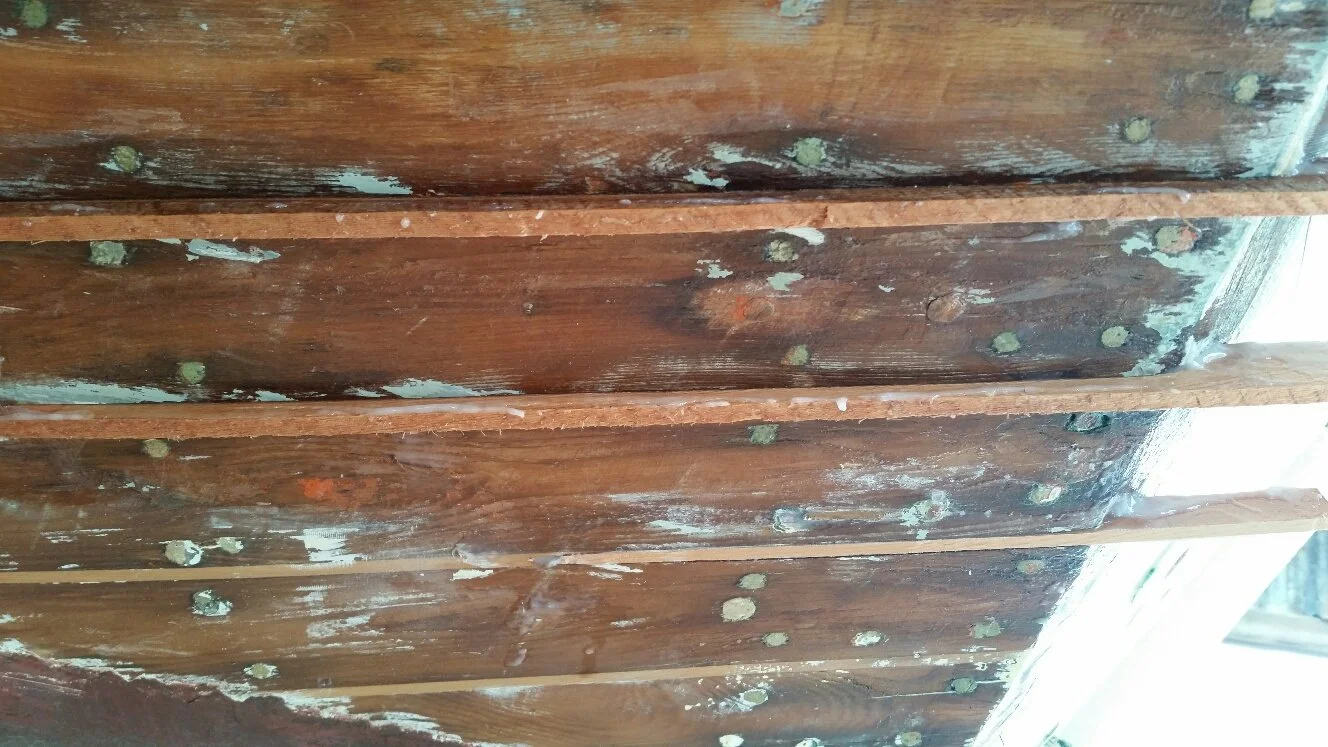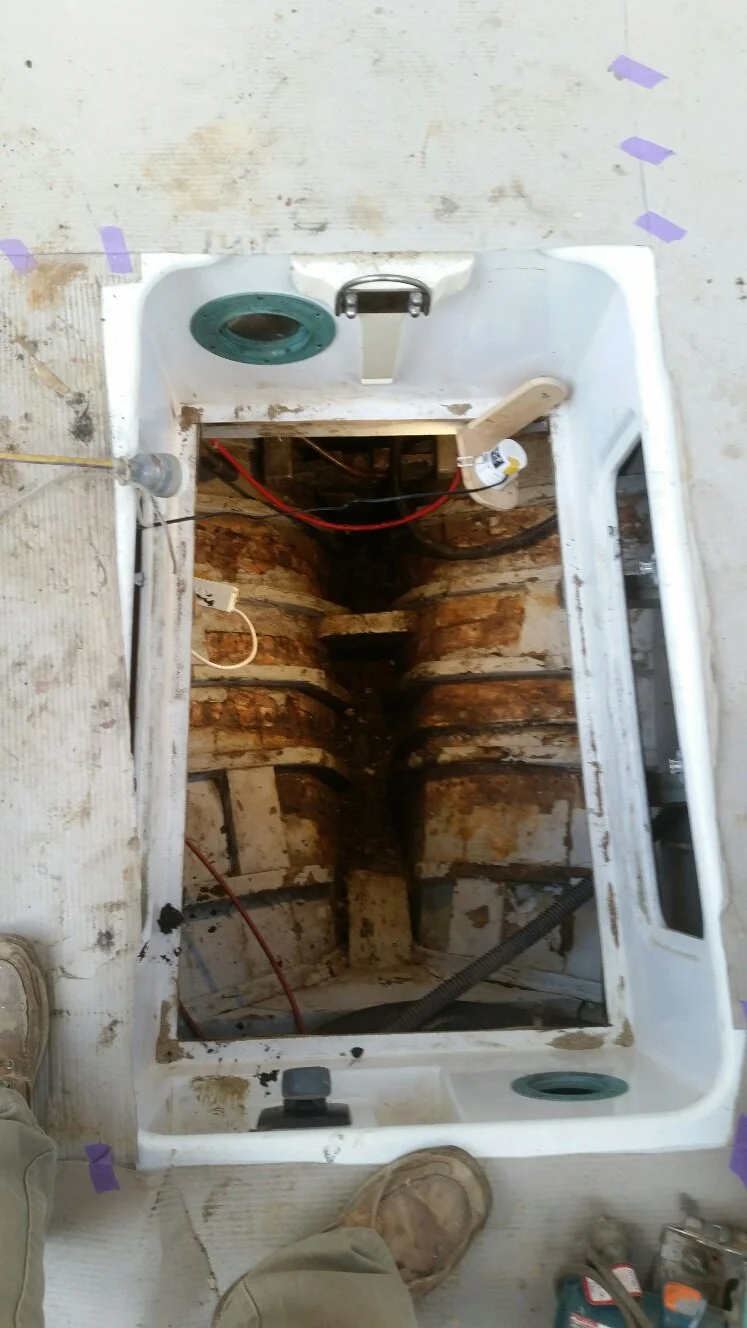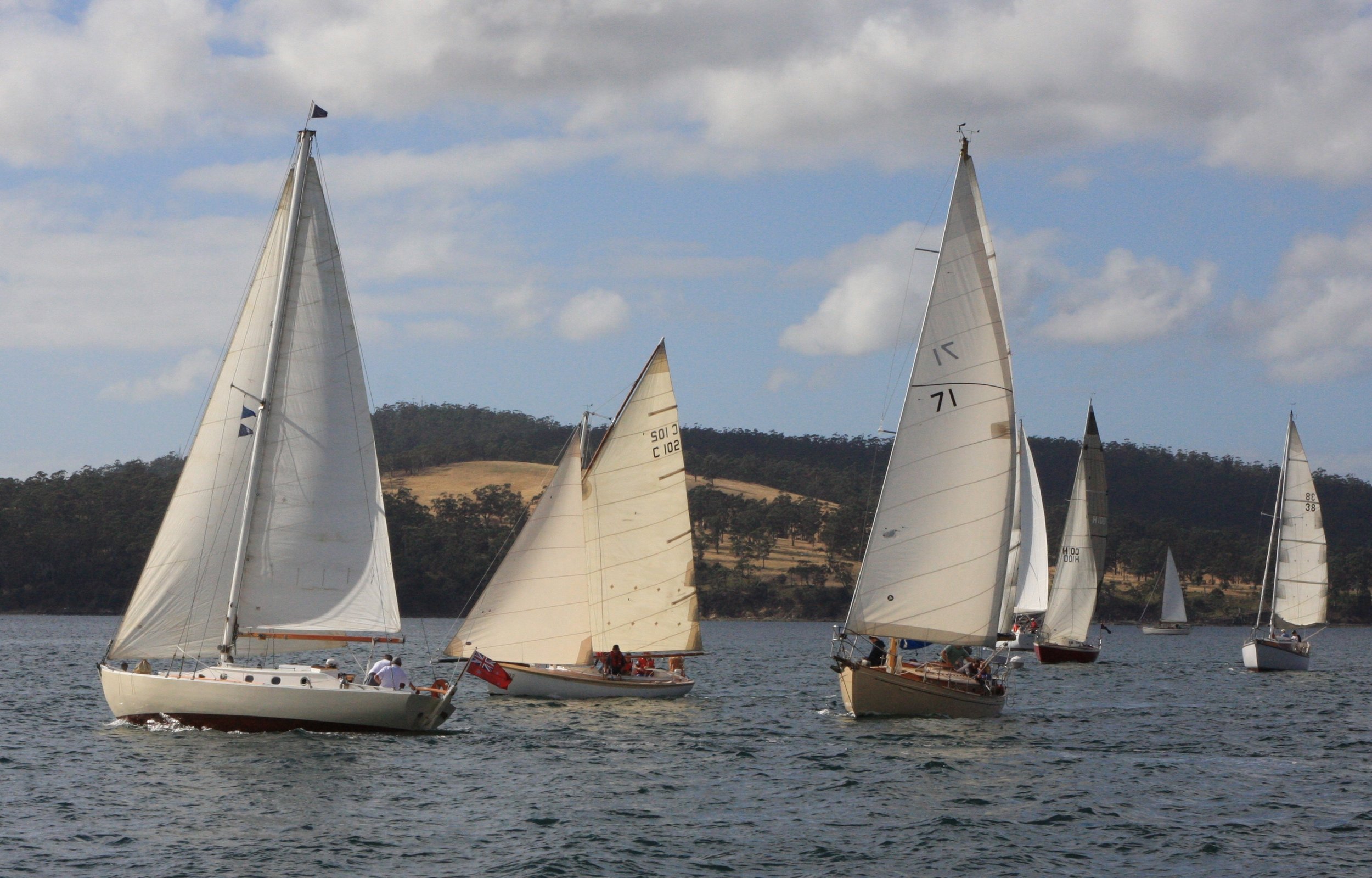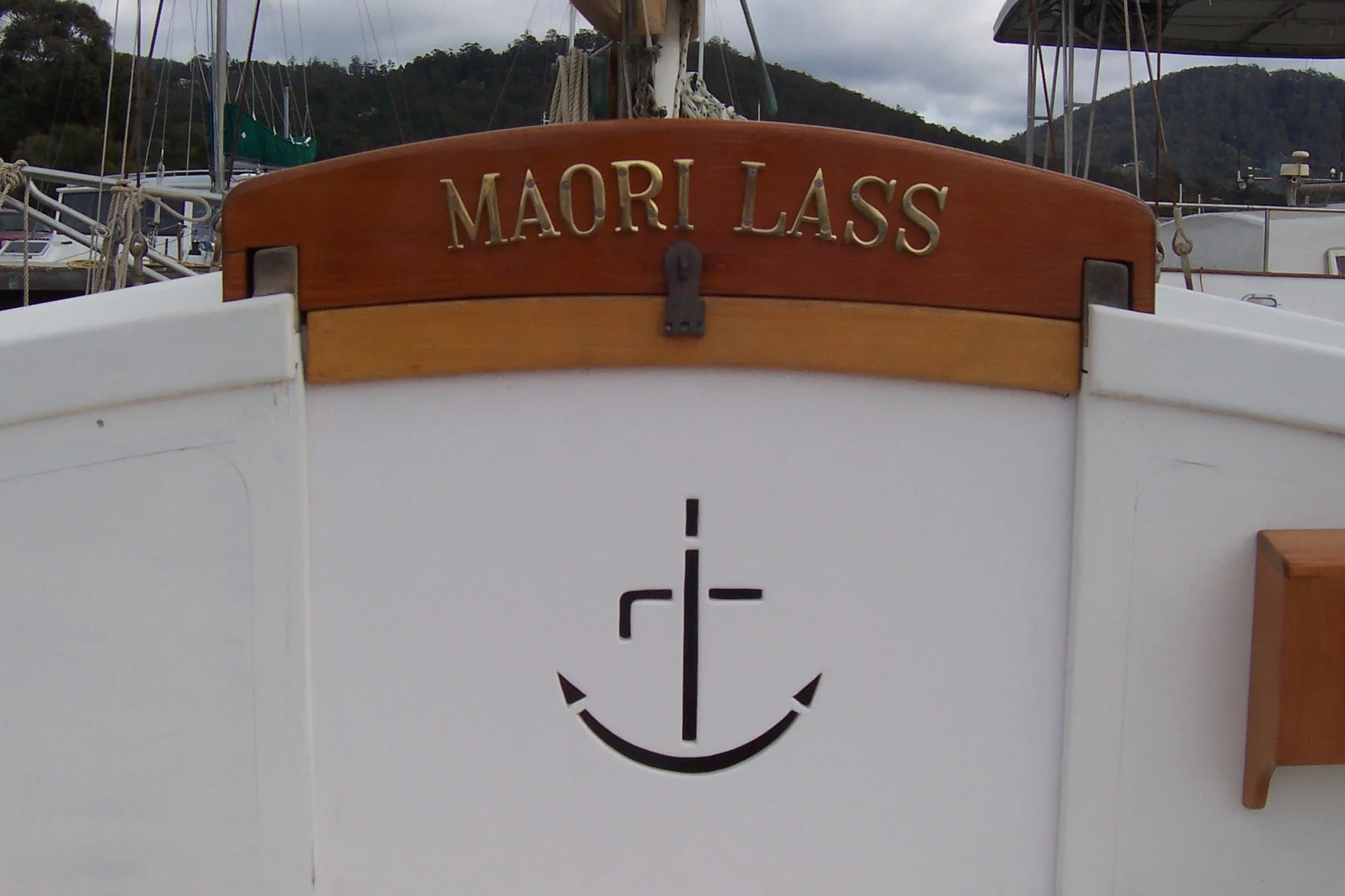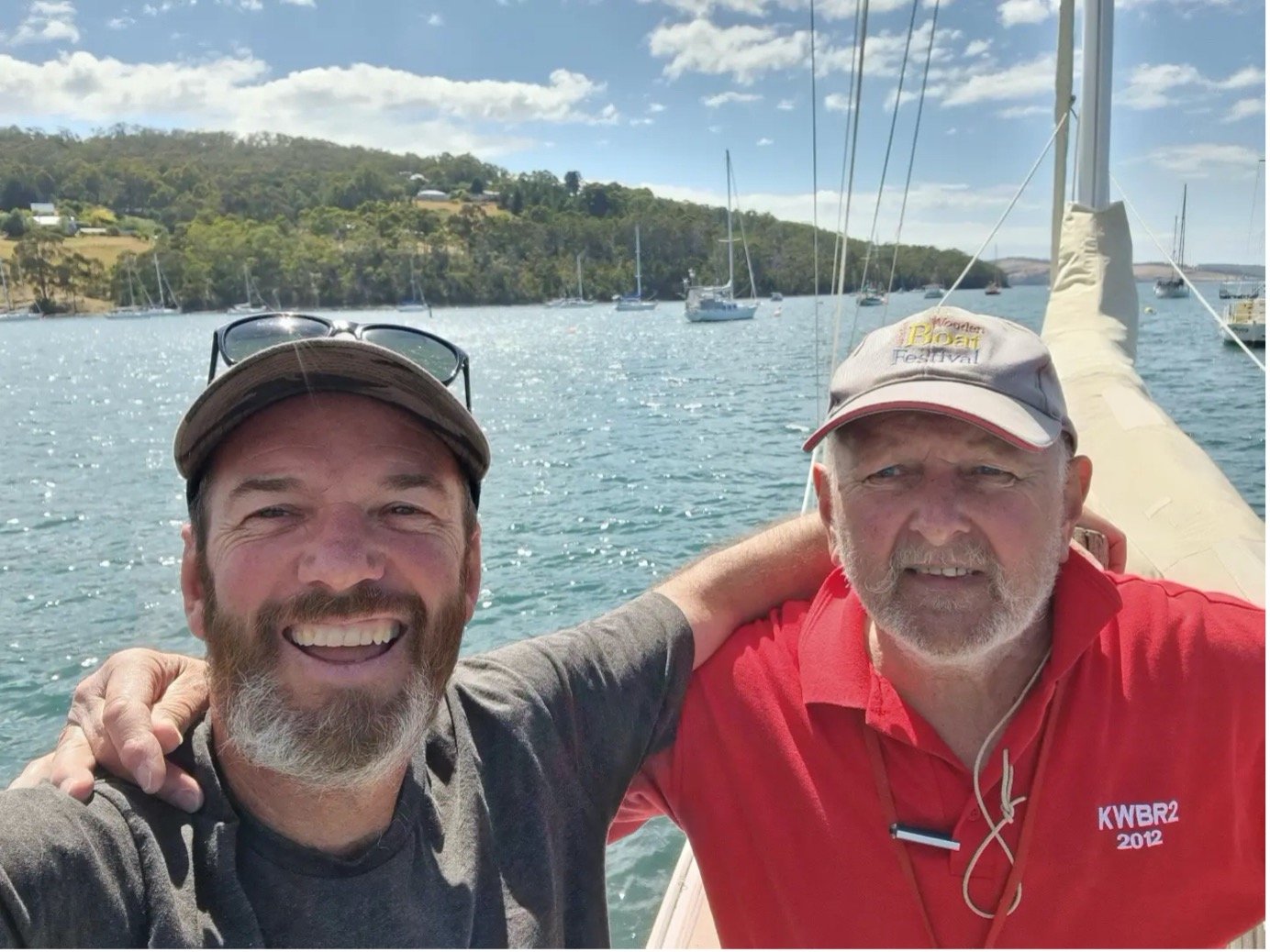MAORI LASS Part II- “She very nearly didn’t make it”
Written by her current custodian, Chris Crerar. (Chris and Maori Lass will be at the 2023 AWBF on the Kings Pier Wharf, so wander along and say hello!)
“She was never built to last this long. She was built in the backyard, took two years, she was a day boat, which you could stay overnight on. But she was never meant to be a Ray Kemp or a Jock Muir Huon Pine long lasting thing. She was just a boat”, says Roscoe Barnett, reflecting on he and Cheryl’s almost 30 years as custodians of Māori Lass, the little 30-footer that’s still going strong, just 2 years shy of her 75th birthday.
The Barnetts’ like to joke that their restoration of Māori Lass took the full 28 years of their time with her and, in some sense, they’re not exaggerating. But it shouldn’t be glossed over that they also enjoyed many years cruising and racing her with friends and family on Sydney’s Pittwater.
“It was meant to be a quick two-year restoration”, says Roscoe.
“20 years later”, Cheryl adds, rolling her eyes.
“Actually, more like 30”, sighs Roscoe.
They’re both philosophical about Māori Lass’ survival against the odds.
“There were numerous points across her history where she very nearly didn’t make it”, says Roscoe. “She’s been in states of disrepair where she may have come perilously close to being scrapped”, he adds.
One such time was back in 1985 when a young Pittwater yacht broker was looking for a boat to live on.
“I wanted somewhere to live. I can’t remember whether it was on the market or not, but I found her”, says Mick Souter, who purchased Māori Lass from Jan and Jim Tabler.
“She got moored up at Scotland Island and just got left”, he says.
“She was definitely not a boat that you’d take on light heartedly at the time. No motor and it leaked a lot”.
Living on her for a couple of years, Māori Lass had the similar deck leaking issues that Jan and Jim Tabler encountered when they first purchased Maori Lass in the early 70s.
“The first year I had on her was probably one of the wettest seasons on record. I remember going to sleep curled up in a bundle in one of the settee bunks trying to stay dry. It was virtually raining inside”, Mick says.
“Sometimes I wondered what the hell I’d done”.
Original decks 1993
Mick worked with shipwright Al Goddard to replace the cabin tops and seal the decks, and soon found he had some real affection for her.
“She’s a beautiful sailboat. In flat water”, he says.
“On Pittwater, I was mixing it with East Coast 31s and Model 33s in the Palm Beach Yacht Club”.
“But as soon as I went offshore, she’s so full in the bow, she’s start going up and down and not forward like you wanted”, laments Mick.
“Saying that, she held the race records from Cronulla to Lion Island return. For many many years. People with 40s would be going, ‘what’s this Māori Lass boat’”.
“It would have been a screaming reach, up and back offshore”, Mick reckons.
The veteran of 8 Sydney to Hobart races, securing an 8th place in one, and 4 Melbourne to Hobart races, with an impressive 3 wins, is quietly spoken and says he’s a bit reclusive these days, but he’s still a great storyteller.
Originally from Tasmania, Mick had been a yacht broker with John Moore at Palm Beach between 1986 and 1995.
He was custodian of Māori Lass until 1993, when he sold her to Cheryl and Roscoe.
“I was still selling boats until I bought a yacht, did the Sydney to Hobart and came home (to Tasmania)”, he says.
“I bought a little 27-footer called Alarm Link Bambino and did the 50th Sydney to Hobart on it”.
“We were doing exceptionally well until we got hit by the south-westerly change and got put upside twice. But we finished. The boat was in a bit of a state, but we finished and beat 100 yachts over the line still”, Mick says, adding that the 1994 50th Sydney to Hobart had around 300 entries.
Looking over Oyster Cove from Mick’s home, pictures of his former yachts adorning the walls, including a 1950s black and white of Māori Lass on the Derwent, he rounds off our chat with one of his favourite Māori Lass stories.
“She has a big hunk of iron bark in the bow. What happened was that a boat broke its mooring and got caught under the bow of Māori Lass and just wore down the stem”, he says, talking about the Pittwater days.
“I’m lying in the bunk one day and next thing there was this chip, chip, chip, bang, bang, bang. All the planks were opened out at the front. And old Jim (Goddard) was sitting in the water and sticks his head in and says, ‘how ya goin Mick. Be back shortly, I gotta get some wood to scarf a new piece in’. He went off and came back with a big piece of iron bark, and he shaped it real quick and banged it in and fastened it all back together again. Just did it all in order. He made it look easy”, laughs Mick.
When Roscoe dropped into Moore’s Brokerage at Palm Beach one sunny afternoon in 1993, he had no idea that it was Mick who was selling Māori Lass. Despite being covered in “seagull shit” Roscoe liked her lines and could see that she had enough room for he and Cheryl and their two young kids.
Nevertheless, Roscoe the stirrer told John Moore; “No, I I’m not going to buy Māori Lass, I don’t even like the name”.
John suggested that the owner might be open to a trade in of their current boat, Tassie Too (a Huon Pine 20’ Ranger). This got Roscoe thinking, and after discussing the proposition with Cheryl, they decided to go for it.
“The day I on got on-board that thing at Palm Beach, I sat in the corner and thought, ‘shit this feels good’, Roscoe says.
“You don’t fall in love with every boat”, he adds.
The Barnetts’ had few clues to the old sloop’s history when they first brought her back to a mooring just out from their home at Church Point.
“There were a couple of clues to her history, but we knew nothing really”, says Cheryl.
“Mick had included a crumpled-up photocopy of an Australian Woman’s Weekly article from 1979 about the Tablers’ sailing her around the world and a Certificate of British Registry”.
“She’s on the Australian registry now but is still registered to Chris Small. In theory, in sort of ‘boat-land’ theory, he still owns her”, Roscoe jokes.
Cheryl and Roscoe joined the Cruising Yacht Club of Pittwater and started going away on weekends with their kids, Blake and Courtney, rafting up with other boats in the beautiful bays and coves of Sydney’s northern waterways.
School holidays Smiths Creek, Kuringai National Park 1993
Christmas raft up in Mushroom Bay, 1996
School holidays, Hawkesbury River Jan 1994
They also entered a few races from the get-go, before undertaking any of the planned restoration works. Except for the eternally leaking decks, which were treated to new ply and dynelled extensively.
“The first few times we sailed around West Head, even with the shitty sails and everything else crappy, and she just went. She sails really well”, says Roscoe.
Winning Palm Beach Yacht Club WB race
After one early race with the Palm Beach Yacht Club, Roscoe tells, they were back on the lawn after the race enjoying a bbq and listening to the results being announced. Roscoe says he was getting a bit agitated as Māori Lass wasn’t rating a mention, only to nearly fall over backwards when they were announced as the race winners.
Roscoe talks with affection and enthusiasm about sailing Māori Lass with the Woody Point Yacht Club.
Blake and Courtney, 1996, Barrenjoey in the background
“It was a real cracker. The best twilight races. The constitution starts off, ‘drinkers with a sailing problem…’”, Roscoe laughs
With a new job in the city and lunch hours to fill, Cheryl became increasingly curious to find out “who this Jan Tabler was”.
Letting her fingers do the walking, Cheryl took a trip around the nation through the once ubiquitous White Pages.
“I started in Sydney, no Tablers. I thought, I’ll go anti-clockwise. Got up to Kunnunara and there was a J. Tabler. Then I went to Queensland, and I found another J. Tabler, but it was disconnected. I thought the next one must be Jan and it was”.
“It was ‘96 or ‘97 and by then we had email, so we kept in touch”, Cheryl says.
Graeme and Jan, February 2005
“They came down in 1998 and we had a sail around Pittwater with the two families, as their kids were the same age as ours by coincidence”.
Easter 1998, Towlers Bay, Blake (aft), Courtney under boom, Jamie & Emma (Jan’s kids) on the bow
A few years earlier in 1994 Cheryl and Roscoe sailed Māori Lass down to Sydney for the wooden boat festival at the Australian Maritime Museum.
“We were sitting in the cockpit under the new awning we’d had made, and a bloke stuck his head under it and said, ‘is this Māori Lass?’ and I said, yeah, and he said, ‘no, the Māori Lass’ and I said, yeah! And he said, ‘I’m Tom Andrewartha’ and I said, you’re dead. And he said, ‘no I’m not, that’s my dad, Ron Andrewartha who built the boat.”
“He said, ‘I’m his son and I helped build the boat’
As they sat on-board chatting, gaps in her history were filled, and they started to gain a sense Māori Lass wasn’t just a boat. She was a repository of memories passed down through the decades.
Previously, Roscoe had thought he’d change her name, as he’d never liked it.
“After he started talking about her and showing me all the stuff, I went urgghh, I can’t change name, can I”, Roscoe says.
Tom Andrewartha told them how she’d been named.
“It was designed by a Kiwi, H.E. Cox, and (Ron) Andrewartha was a Kiwi and just before they launched it, they hadn’t really thought of a name, and Mrs Andrewartha said, ‘what are you going to call her’, and they said, ‘oh well, maybe we’ll call her Māori Lass, and she said, ‘oh yeah, that’ll do’.
Māori Lass she was, and Māori Lass she remains.
Cheryl says that Roscoe’s appreciation of Māori Lass changed after meeting Tom. He became a custodian.
“He changed his thoughts and direction. He realised it’s a bit of history”, says Cheryl.
Roscoe travelled down to Hobart early the following year, attending the Australian Wooden Boat Festival (AWBF) and visiting the home of Tom Andrewartha.
“After we met Tom and came down here (Hobart) for the festival and went to Tom’s house, I went oh, she’s not just another boat”.
“She’s a boat that sailed around here (Hobart), then went to Port Hacking, and then to Pittwater, then to the world, then back to Pittwater, then we had her. So, she’s been here, there and everywhere”, Roscoe says.
“She’s wandered around for a few years”.
Tom gave Roscoe a stack of photos, some club trophies from the 50’s and the original plans.
Soon after returning to Sydney, Tom asked for the plans back.
“I said to him, what sort of Indian giver are you”, Roscoe laughs.
Tom told Roscoe about the scale model of Māori Lass that his younger brother Bob had begun as a teen in the 1950s but had never completed because he probably discovered “sex, drugs and rock n roll”.
Bob Andrewartha’s model
Roscoe believes the Andrewarthas’ reconnection with Māori Lassi inspired Bob to complete the model.
Roscoe and Cheryl didn’t meet Bob until they, like many before them, fell under the spell of Tasmania and moved their family south.
When Bob moved into a retirement unit, he no longer had room for the model and asked the Barnetts if they’d look after it.
The highly accurate scale model in a glass case is one of the first things you see as you step inside Cheryl and Roscoe’s Tinderbox home. Bob has long passed way, but they’re still looking after his model.
Bob and Tom both visited Māori Lass when she finally returned home and appeared in her first AWBF in 2005.
Bob (L) and Tom (sons) Andrewartha, AWBF 2005
Bob Andrewartha on-board Māori Lass, AWBF 2005
However, when the Barnetts moved to Tasmania, bringing Māori Lass south from Sydney nearly didn’t happen.
“When we moved down here, I said to Cheryl, I wanted to get a cray boat”, Roscoe says.
Roscoe wanted a cabin for the cold weather and a big engine to push them through Tasmania’s turbulent waters.
But Roscoe’s shipwright mate from Tasmania, Terry Lean (ex Sydney) was cruising around Pittwater and saw Māori Lass on her mooring.
“Oh shit, she’s not looking real happy. She’s a real mess Roscoe, you can’t leave her like that”, Terry said.
Terry advocated bringing Māori Lass down to Tasmania and restoring her. But he also said she was in no state to sail down and getting repairs done in Sydney would cost a bomb and pressed for her to be trucked south.
Back then, Terry was the lead shipwright at The Wooden Boat Centre in Franklin. Under Terry’s instruction Roscoe built a cradle for Māori Lass and this became her home for the next 6 months and she underwent extensive works.
“He used her as an example of a restoration job. She had a big makeover”, Roscoe says.
Terry, Roscoe and diploma students at the Wooden Boat Centre carried out extensive works, including gutting the interior, scarfing in 14 new half-ribs amidships, refastening from the garboard to the floors, splined the keel to the waterline and installed a new mast-step.
Leaving the Wooden Boat Centre, 2005
In 2005 Roscoe, who by now had a shop in Battery Point called Roscoe’s Boat Bits, joined the AWBF Board, then moved to the 2007 organising committee as Dock Master, a position he will have undertaken for 9 consecutive festivals, including the forthcoming 2023 AWBF.
By association with the festival, works undertaken on Māori Lass have been well reported through the AWBF’s media channels and a quick Google search reveals articles and images detailing restoration work on her.
There’s also the odd dig back at the stirrer himself, including this one.
“We caught up with Ross here in the AWBF office recently to see how things were going:
AWBF: So, Roscoe, having started the re-fit back in September, how is that 6-week project coming along?
RB: Have you seen the state of those ribs? It’s like a jungle in there! Christmas. We should be done by Christmas. Well, soon after Christmas, anyway.
AWBF: That’s OK, Roscoe, but the next festival is just 13 months away. Do you reckon you’ll be clear by then? We need our Dock Master back, after all.
RB: Leave it with me. (walks away with a limp where his wallet used to be)”
Determined to clock up that 20–30-year restoration, Roscoe pulled Māori Lass out of the water again for another round of works in 2016.
Again, working with Terry Lean, this time at the famed Wilson’s Boat Shed in Gardners Bay on the Huon River, Roscoe spent 8 months travelling back and forth on an almost daily basis assisting Terry to complete a long list of works.
Arriving at Wilsons shed 2017
“By the time we finished, I was a second-year apprentice”, says Roscoe.
Again, Roscoe and Terry stripped out her interior, this time to install 36 new laminated half-ribs and 12 new full-length ribs under the chain plates. Putting in around 1150 hours on her, they also removed her old Bukh engine, created a cockpit hatch allowing access to cracked ribs on the turn of the bilge, rebored the stern shaft hole installing a fiberglass stern tube and dripless gland, installed new laminated floors and a new stepped mast, spreaders and new stainless-steel rigging.
The old ribs as they came out, Wilsons 2017
New laminated ribs ready to be installed, Wilsons 2017
Splining, Wilsons 2018
New bilge after completed work, Wilsons 2018
State of destruction under the cockpit, Wilsons 2017
In deciding to do these latest major works, Cheryl and Roscoe contemplated two options. Either leave her as she was and allow time to take its toll or set her up for future chapters.
“I said to Cheryl, do we do that, or do we bite the bullet and make her work for another 50 years?”.
The responsibility of custodianship and wanting to do the right thing by the boat which held so memories for the Barnetts and all before them, held sway, and with Terry, Roscoe brought Maori Lass up to a standard they felt she deserved.
After 8-months of restoration work, she was re-launched while Roscoe was away in Melbourne.
“When I came back, I looked down at her and thought, fark she looks good. That was worth it”, Roscoe says.
A new Nanni engine found its way into Māori Lass and Roscoe spent most of his days finishing off her new galley and tinkering with the interior.
“Then the realisation came, what am I going to do with her now”.
Participating in the Kettering Wooden Boat Rally.
Roscoe still held dreamt of heading off down the D’Entrecasteaux Channel in his own pilothouse motor-sailor.
In 2021, and after almost 30 years with Māori Lass as an integral part of the Barnett family, Cheryl and Roscoe decided it was time for her next chapter.
Roscoe in the saloon of the finally completed Māori Lass in 2022, just before handing her over to her new custodian
Roscoe did find that pilothouse motor-sailor (Barameda will feature in the 2023 AWBF) and a new custodian stepped forward for Maori Lass, but like the Andrewarthas, Jan Tabler and Mick Souter, the Barnetts are forever connected to her.
Roscoe farewelling Māori Lass, Kettering, Feb 2022
Māori Lass’ latest crew participating in a 2022 Kettering Yacht Club twilight race.
And Roscoe still marvels at this little ship’s considerable history.
“When you lie in the bunk and you think about how many sea miles she’s done, and how many sea bottoms she’s been over, you think fark”.
Chris Crerar with Roscoe on the day he became Māori Lass’ latest custodian.
If you missed part one of the Maori Lass Story-CLICK HERE









